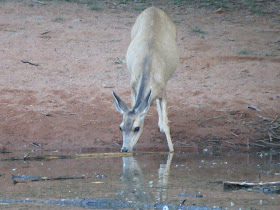Last Friday through Sunday, July 19-21, scientists and citizen scientists descended on one of the most popular recreation sites in Colorado Springs, Colorado: Red Rock Canyon Open Space. The goal was to find as many species of living things as possible in that short time period, and I dare say that we exceeded expectations.
Red Rock Canyon was the first Open Space to be dedicated in Colorado Springs, purchased by the city back in 2003. It took ten years to complete the master plan for the 1,474 acre area. It includes an abandoned quarry, a couple of small reservoirs, and several habitats, from dense coniferous forests in its upper reaches to shortgrass prairie and meadows on the lower slopes and plateaus. It is perhaps better known for its extinct animal life, preserved as fossils in the stone outcrops and uplifts, than it is for what lives there now.
Hiking, trail running, horseback riding, rock climbing, and limited mountain biking are all favorite activities for humans who frequent the park. This heavy activity usually presents conflicts with those trying to observe wildlife, but animals in the park are now so adapted to people traffic that the deer all but say "excuse me" as they hustle past you to get a drink at one of the reservoirs.
When I first proposed the idea of doing a single bioblitz to then-TOPS (Trails, Open Spaces and Parks Program) Manager Chris Leiber back in 2016, he envisioned the event at Red Rock Canyon. That proposal morphed into four bioblitzes at other Open Spaces in celebration of the twentieth anniversary of TOPS in 2017. Finally, we come full circle.
Colorado Springs has endured an unusually wet, cool spring and early summer, making for lush vegetation, but a relative dearth of insect life. Wildflower blooms this year have been short, sporadic, and far-flung, the distances between clumps of flowers greater than normal. The cool weather turned immediately into a heat wave of 90-plus degrees, punctuated with near daily afternoon thunderstorms, and that is what we faced for the bioblitz.
Thankfully, we had a dry, hot night Friday night (July 19) on which to do blacklighting for moths and other insects, and it was epic.
We had three stations, two featuring bright mercury vapor lights to draw insects from farther distances, and one that was outfitted "only" with an ultraviolet (UV) light. All three stations were humming with activity and no two people saw the same insects and arachnids.
During the day, participants fanned out from "base camp" under a pavilion near the reservoirs to explore the surrounding landscape. One of our entomologists, Rose Ludwig, made an exceptional discovery when she took photos of a small, male clearwing moth on Saturday. She revisited the same location on Sunday and got images of the female.
All our images and observations were recorded in an iNaturalist project, and there was immediate interest in Rose's find. It turns out to be a Colorado state record for Carmenta wildishorum, a species described only two years ago from specimens taken in New Mexico.
Tim Leppek, Aaron Driscoll, Kaya Woodall, Debbie Barnes-Shankster, Bill Shankster, Heidi Eaton, and myself added even more observations of various arthropods to complement the work of botanists, mammologists, birders, and mycologists.
With the results of mammal and fungi experts still pending, we have already amassed a stunning 481 taxa (classifications ranging from family-level to species-level) for less than three full days of exploration. Many family designations include more than one genus or species, so numbers are likely to increase as more specific identifications are made. Still, not every genus or species can be identified from images alone. The mushroom experts will be doing detailed DNA work to arrive at their conclusions, for example.
The Red Rock Canyon Open Space bioblitz concluded appropriately when the volunteer organizer, Sharon Milito, was presented with a Spirit of the Springs Celebration Award by Mayor John Suthers. Sharon has become a great friend and mentor over the last three years, and without her we would not have bioblitzes and I would not have gotten to visit Jimmy Camp Creek Park and Corral Bluffs Open Space, parcels that are not yet open to the public. I cannot think of anyone more deserving of this honor.
Please do check out the iNaturalist project page, hyperlinked a couple paragraphs back, to see the full results of this undertaking. I wish to thank Bell Mead, and Renee McDougal for facilitating involvement of the Mile High Bug Club in all the bioblitzes, and managing our club's booth at base camp.














No comments:
Post a Comment
Blog author currently unable to reply to reader comments, nor comment himself. Working to resolve this.